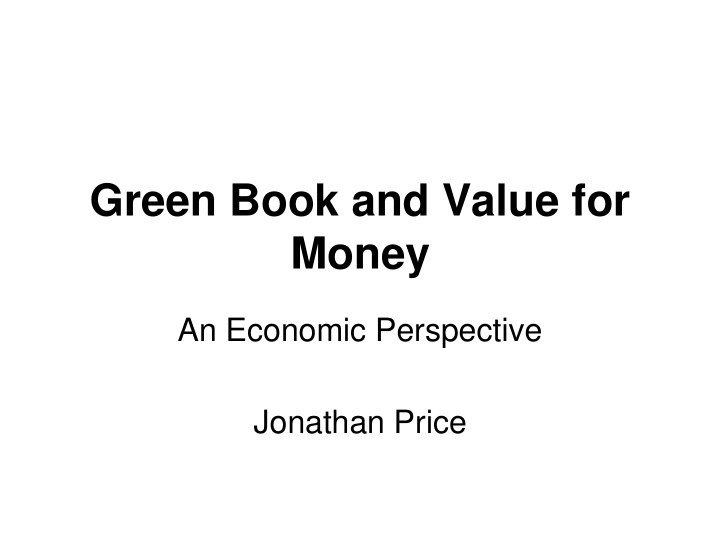



Green Book and Value for Money An Economic Perspective Jonathan Price
The Green Book: The Green Book is HM Treasury guidance for Central Government, setting out a framework for the appraisal and evaluation of all policies, programmes and projects. It sets out the key stages in the development of a proposal from the articulation of the rationale for intervention and the setting of objectives, through to options appraisal and, eventually, implementation and evaluation. It describes how the economic, financial, social and environmental assessments of a proposal should be combined and aims to ensure consistency and transparency in the appraisal process throughout government.
Aims: • Set out key principles that, if followed, can help to deliver good VFM (in widest sense) • Suggest practical steps that can be taken in applying the principles • In the context of “austerity” – emphasis on review
1. DOES GOVERNMENT REALLY NEED TO DO THIS AT ALL? IF SO, CAN WE SCALE IT BACK? • Principle 1: Everything we do has an “ opportunity cost ” – in other words, resources that are used up could be employed to deliver other benefits (even if the resources are non-financial, such as the use of an asset).
1. DOES GOVERNMENT REALLY NEED TO DO THIS AT ALL? IF SO, CAN WE SCALE IT BACK? • Principle 2: Effective action needs a sound rationale. Are there good reasons to think that government action is likely to be cost-effective in this area?
1. DOES GOVERNMENT REALLY NEED TO DO THIS AT ALL? IF SO, CAN WE SCALE IT BACK? • Principle 3: Consider incremental costs and benefits. Are the bulk of the benefits delivered by the initial allocation of resources, with progressively fewer benefits being delivered as more resources are allocated? If so, consider cutting back.
2. HOW CAN GOVERNMENT ACTIONS IMPROVE OUTCOMES IN THIS AREA? IS THERE A “MARKET FAILURE”? • Principle 4: Be clear whether the rationale for intervention is social or economic (or both). Economic interventions need to be justified by reference to “market failure”. This is NOT a simple failure to deliver a desired outcome, but a specific failure of the market system to extract the maximum value from the available resources.
2. HOW CAN GOVERNMENT ACTIONS IMPROVE OUTCOMES IN THIS AREA? IS THERE A “MARKET FAILURE”? • Principle 5: Take account of government failure. Do not assume that government action will be implemented perfectly (or without cost).
3. HOW GOOD IS THE EVIDENCE? • Principle 6: Take full account of quality of the evidence on (likely) cost- effectiveness. In general, anecdote and opinion, even when from experts, should be valued less than the results of multiple, rigorous studies.
3. HOW GOOD IS THE EVIDENCE? • Principle 7: Take proper account of offsetting effects. “Deadweight” and “displacement” should always be considered.
3. HOW GOOD IS THE EVIDENCE? • Principle 8: Proportionality. The allocation of resources to the production of evidence should be proportional to the scale of the resources associated with the activity in question.
4. IS THE FOCUS ON ENDS, NOT MEANS? • Principle 9: Assess effectiveness in terms of outcomes or outputs, not inputs. If it is not possible to assess outcomes or outputs reliably, consider whether to cut spending.
4. IS THE FOCUS ON ENDS, NOT MEANS? • Principle 10: Consider whether outcomes or outputs are the better metric for assessing effectiveness.
4. IS THE FOCUS ON ENDS, NOT MEANS? • Principle 11: Consider a wide range of options, including “do something”, “do minimum” and “do nothing” (see also principle 3).
5. DO INCENTIVES PROMOTE COST-EFFECTIVESS? • Principle 12: Cost-minimisation should be promoted.
5. DO INCENTIVES PROMOTE COST-EFFECTIVESS? • Principle 13: A degree of contestability should exist such that poor delivery agents can be replaced.
5. DO INCENTIVES PROMOTE COST-EFFECTIVESS? • Principle 14: Ensure that there are periodic reviews and “break points”, such that the use of resources or regulations is challenged appropriately.
Introducing the Magenta Book guidance on evaluation Richard Thurston
Evaluation challenges • Devolution • Lack of previous experience of evaluation • Competing pressures • Ad hoc use • Not part of core business • Confusion over terms • Few incentives • Lack of awareness • Fear of negative results • professional capacity • Quality of evaluation methodologies • Addressing data deficits • Poor reporting & application of evaluation evidence • Using evidence from other evaluations
The Magenta Book • HM Treasury guidance • Standards of good practice in conducting evaluations • Focused on the issues faced when undertaking evaluations • Can be used in relation to projects, policies, programmes and the delivery of services. • Focused on actual implementation and impacts of a policy to assess whether the anticipated effects, costs and benefits were in fact realised. • But not a text book
Part A – written for policy makers • Key issues in policy evaluation • Identifying the right evaluation for the policy • Building impact evaluation into policy design • Practical issues to take into account when designing an evaluation
Part B – written for analysts (and interested policy makers) • The stages of an evaluation • Setting-out the evaluation framework • Data collection • Process evaluation, action research and case studies • Empirical impact evaluation • Drawing together and reporting evaluation evidence.
Green Book: http://www.hm-treasury.gov.uk/data_greenbook_index.htm Magenta Book: http://www.hm-treasury.gov.uk/data_magentabook_index.htm Richard Thurston Welsh Government Knowledge and Analytical Services Richard.thurston@wales.gsi.gov.uk 029 20825324 www.wales.gov.uk/research
Recommend
More recommend